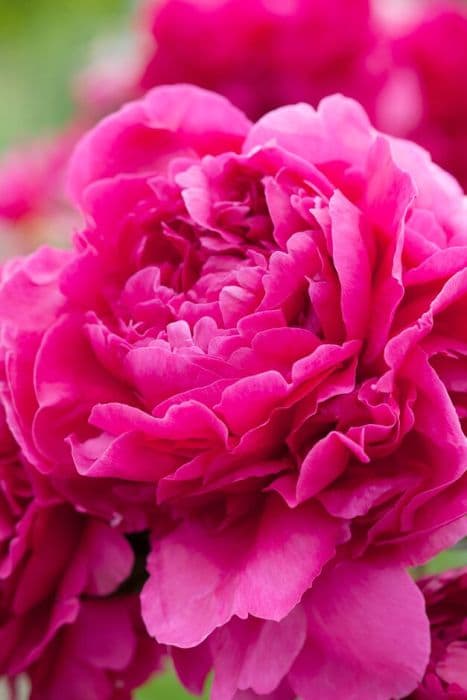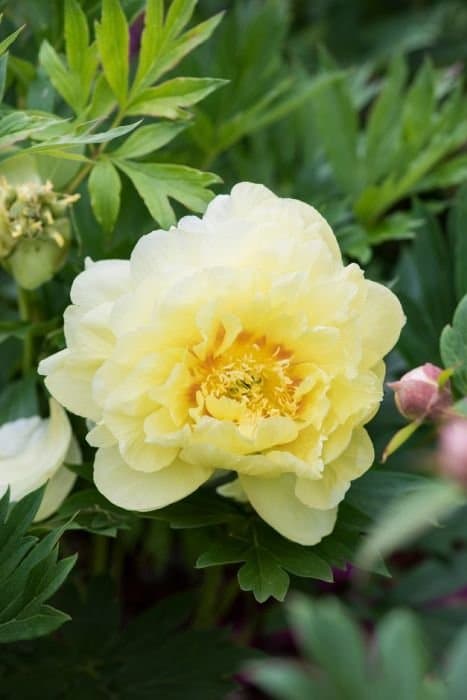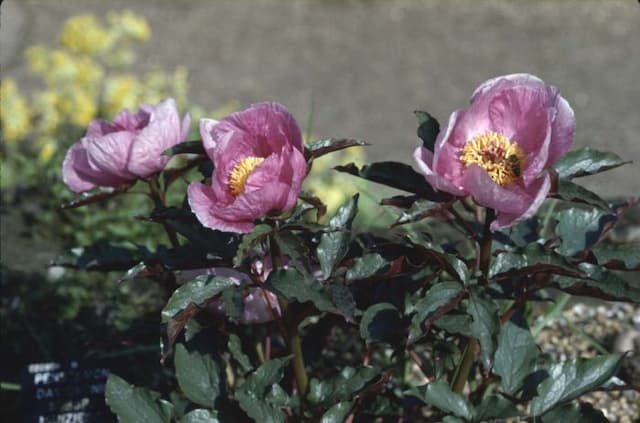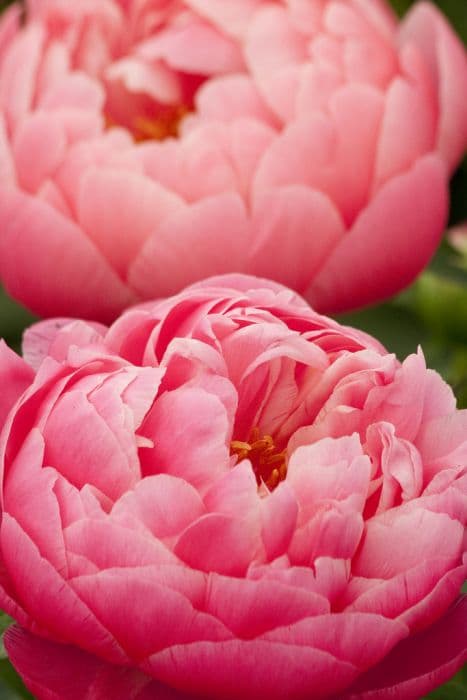Peony Paeonia lactiflora 'Paul M. Wild'

ABOUT
The Paeonia lactiflora 'Paul M. Wild', commonly known as a peony, is a popular ornamental flowering plant cherished for its large, vibrant blossoms. It produces an abundance of double, cup-shaped flowers with a rich, deep magenta color that can captivate the eyes of any onlooker. The fragrant flowers are densely packed with ruffled petals, creating a lush, full appearance that exudes elegance and romance. The foliage of the peony provides a lush backdrop for its stunning flowers, with glossy, dark green leaves that have a somewhat leathery texture. These leaves are divided into leaflets, giving them a compound look that adds to the plant's ornamental value. The foliage often presents a slightly curved or serrated margin, contributing additional visual interest. Overall, this peony variety stands out with its impressive floral display that can add a splash of dramatic color to any garden. The plant is a staple in many temperate gardens, where its seasonal blooms become a focal point during their flowering period. Its leaves, lasting beyond the bloom time, maintain the plant's attractiveness throughout the growing season, until they die back when the colder temperatures of late fall and winter arrive.
About this plant
 Names
NamesFamily
Paeoniaceae
Synonyms
Chinese Peony, Common Garden Peony
Common names
Paeonia lactiflora 'Paul M. Wild'.
 Toxicity
ToxicityTo humans
The peony, Paeonia lactiflora 'Paul M. Wild', is generally considered non-toxic to humans. While it is typically safe to handle and grow, ingesting parts of the plant is not recommended as it may cause mild gastrointestinal upset in sensitive individuals.
To pets
For pets, particularly cats and dogs, the peony can be toxic if ingested. If a pet consumes any part of a peony plant, they may experience symptoms such as vomiting or diarrhea. It's important for pet owners to prevent their animals from ingesting the plant to avoid these mild to moderate gastrointestinal upset symptoms.
 Characteristics
CharacteristicsLife cycle
Perennials
Foliage type
Deciduous
Color of leaves
Green
Flower color
Red
Height
2-3 feet (60-90 cm)
Spread
2-3 feet (60-90 cm)
Plant type
Herb
Hardiness zones
3-8
Native area
China
Benefits
 General Benefits
General Benefits- Aesthetic Appeal: Paeonia lactiflora 'Paul M. Wild', commonly known as peony, produces vibrant deep-pink blossoms that can enhance the visual beauty of gardens and landscapes.
- Fragrance: The large double flowers emit a pleasing fragrance that can add a sensory layer to garden experiences.
- Longevity: Peonies are perennials with a long lifespan, providing years of enjoyment with proper care.
- Cut Flower Use: The blooms make excellent cut flowers and can create striking arrangements with a long vase life.
- Seasonal Interest: They provide a burst of color in the spring and can help mark the changing of seasons in a garden.
- Pollinator Attraction: While actively blooming, peonies can attract pollinators such as bees, which are essential for a healthy ecosystem.
- Easy Care: Once established, peonies are relatively low maintenance, requiring minimal care beyond basic watering and fertilizing.
- Versatility: Peonies can be planted in border gardens, as focal points, or in clusters, providing flexibility in garden design.
 Medical Properties
Medical PropertiesThis plant is not used for medical purposes.
 Air-purifying Qualities
Air-purifying QualitiesThis plant is not specifically known for air purifying qualities.
 Other Uses
Other Uses- Artistic Inspiration: Peony blooms have often inspired artists and photographers due to their lush petals and vibrant colors, making them a frequent subject in paintings and artistic photography.
- Fabric Dyeing: The roots and flowers of peonies can be used to create natural dyes for fabrics, producing a range of colors from soft yellows to rich browns.
- Landscape Design: 'Paul M. Wild' peonies are commonly used in landscape design for their extravagant blooms and the aesthetic appeal they add to gardens and parks.
- Culinary Garnish: While not a common practice, the petals of peonies can be used to add a splash of color and a mild, sweet flavor as garnishes in haute cuisine.
- Eco-Friendly Confetti: Dried peony petals can serve as a biodegradable alternative to traditional paper confetti at celebrations, reducing environmental impact.
- Craft Supplies: Dried peony petals and blooms can be incorporated into various crafts, such as making homemade potpourri or decorations for greeting cards and invitations.
- Perfumery: Peony's subtle fragrance is sometimes used in making perfumes and scented candles, although it's not as commonly used as other flowers like roses.
- Symbolic Gift: In certain cultures, peonies represent honor, fortune, and a happy marriage, making them a meaningful gift for weddings and anniversaries.
- Floral Baths: Detoxifying and aromatic floral baths can include peony petals for a luxurious and calming experience.
- Bee-friendly Gardens: Planting peonies can help support the local bee population as they provide a source of nectar when in bloom.
Interesting Facts
 Feng Shui
Feng ShuiPeonies are used in Feng Shui to promote love and romance, and are often utilized in the southwest area of a garden or home to enhance relationship luck.
 Zodiac Sign Compitability
Zodiac Sign CompitabilityThe peony is not used in astrology practice.
 Plant Symbolism
Plant Symbolism- Prosperity: Paeonia lactiflora, commonly known as peony, often symbolizes wealth and honor, which is why it's commonly used in festive occasions and celebrations.
- Romance: Peonies are also associated with love and affection, making them popular in wedding bouquets and romantic gestures.
- Beauty: With their full, rounded blooms, peonies are often seen as a symbol of beauty in various cultures, embodying elegance and charm.
- Good Fortune: In some traditions, peonies are believed to bring good luck and positive outcomes, especially when given as gifts.
- Compassion: The soft and delicate nature of peonies can represent compassion and empathy, suggesting a gentle and understanding heart.
 Water
WaterPeonies, including the 'Paul M. Wild' variety, prefer their soil to be kept evenly moist, especially during the growing season. Water them once a week, providing about 1 inch of water, which roughly translates to 0.62 gallons per square yard of soil. It’s important to avoid overhead watering to prevent fungal diseases; instead, water at the base of the plant. During periods of drought or extreme heat, you may need to water more frequently to maintain moisture levels. Cut back on watering as the plant goes dormant in the fall.
 Light
LightPeonies like 'Paul M. Wild' perform best in full sun, meaning they should receive at least six hours of direct sunlight daily. They can tolerate light afternoon shade, especially in hotter climates, but too much shade will reduce flowering. A spot that gets bright, morning sunlight is ideal to enhance flower production and keep the foliage dry, which helps prevent disease.
 Temperature
TemperatureThe 'Paul M. Wild' Peony thrives in a temperate climate and will do best in temperatures between 65°F and 75°F. While peonies can survive temperature extremes of a winter low around -20°F and summer highs reaching 90°F, prolonged temperatures outside their comfort zone can affect their health and blooming. The ideal growing condition also involves a period of winter chill to ensure proper dormancy and subsequent flowering.
 Pruning
PruningPeonies, such as 'Paul M. Wild', should be pruned to remove spent flowers and deadhead to encourage growth and maintain a tidy appearance. This typically occurs after blooming in late spring or early summer. Cutting back the foliage to ground level in the fall after frost has killed off the leaves is also recommended to prevent overwintering diseases. Pruning in the fall is essential because it removes potential sources of infection and prepares the plant for its dormant period.
 Cleaning
CleaningAs needed
 Soil
SoilPeonies like 'Paul M. Wild' thrive in well-draining soil with a pH of 6.5 to 7.5. A good mix comprises two parts loam, one part peat moss, and one part sand to ensure adequate drainage and fertility.
 Repotting
RepottingPeonies such as 'Paul M. Wild' seldom need repotting as they prefer to be left undisturbed and can thrive in the same location for many years.
 Humidity & Misting
Humidity & MistingPeonies like 'Paul M. Wild' are not particularly humidity-sensitive and can tolerate the average outdoor humidity in the regions they grow well.
 Suitable locations
Suitable locationsIndoor
Generally not suited for indoor growing; requires cold dormancy.
Outdoor
Plant in full sun, well-draining soil, and shelter from strong winds.
Hardiness zone
3-8 USDA
 Life cycle
Life cycleThe life cycle of Paeonia lactiflora 'Paul M. Wild', commonly known as Chinese peony or common garden peony, begins with seed germination, which requires a period of stratification to break dormancy. After germination, the seedling develops a small root system and a shoot that emerges above the soil, forming the first true leaves. As the plant matures, it forms a larger root structure with tuberous roots that store energy, and it produces a clump of compound, deeply lobed leaves each year. The peony enters a stage of vegetative growth annually in the spring, leading to the development of large, fragrant flowers, typically blooming in late spring to early summer. After flowering, the plant sets seeds in the form of a capsule if pollination occurs, completing its reproductive cycle. During the fall, the peony plant dies back to the ground before entering a period of dormancy in winter, conserving energy in its roots for the cycle to begin anew in the spring.
 Propogation
PropogationPropogation time
Late winter to early spring
The most popular method of propagation for Paeonia lactiflora 'Paul M. Wild', commonly known as the peony, is through division of the root system. This is best done in the fall after the plants have died back. To propagate, carefully dig up the peony plant, ensuring a large mass of roots is retained. The root mass should then be divided into sections, each with at least three to five eyes, which are the potential growth points for new stems. These sections should be replanted promptly, at a depth where the eyes are no more than 1 to 2 inches (approximately 2.5 to 5 centimeters) below the soil surface, and spaced about 3 feet (about 90 centimeters) apart to allow for mature growth. Water the newly planted divisions thoroughly to settle the soil and help reduce transplant shock. This method of division helps to rejuvenate older plants, encouraging more vigorous growth and flowering.









